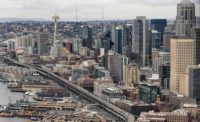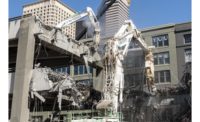Crews Demolish Seattle Viaduct in Tight Quarters

As each section is demolished, contractors retain a 4-ft pile of rubble to absorb impact from falling debris.
PHOTO COURTESY WSDOT

With the project’s proximity to existing buildings and active roadways, crews must take safety and environmental training before setting foot on site and participate in regular safety meetings.
PHOTO COURTESY WSDOT

Once demolition is complete, the $724-million Waterfront Seattle plan will add a rebuilt seawall, new surface streets, parks, paths and bay access.
PHOTO COURTESY WSDOT

Some occupied buildings are located just 8 in. from bridge columns, eliminating explosives as an option and making mechanical demolition the only viable method.
PHOTO COURTESY WSDOT

Demolition subcontractor Ferma developed proprietary equipment to work from different heights and for dealing with material of mixed degrees of thickness.
PHOTO COURTESY WSDOT





As Washington State Dept. of Transportation celebrates the opening of State Route 99 tunnel under downtown Seattle, the new roadway passage allowed WSDOT to focus on removing the 1.4-mile-long Alaskan Way Viaduct, an aging structure opened in 1953 and deemed susceptible to earthquakes.
Demolition in the tightly packed downtown core takes a delicate touch. With the viaduct hovering over a key utility corridor for Seattle, contractor Kiewit Infrastructure West must pay special attention to ensure the safety of the utilities buried under the viaduct. To do so, they use 4 ft of viaduct rubble as a way to absorb the impact from falling debris, protecting the utilities underneath and helping prevent rubble from splashing out.
Cushioning the falling concrete and steel isn’t the only challenge on the job. Crews must also contend with numerous buildings in close proximity and the logistics puzzle of how to dispose of material.
Out With the Old
The dire need of replacement served as the main catalyst for the $3.3-billion tunnel and State Route 99 project, and the current viaduct removal serves as the cornerstone of that effort.
Demolition of the viaduct started in February, immediately following the opening of the fresh roadway. The $93.7-million demolition project, scheduled for six months, was awarded in May 2018, giving Kiewit time to plan and coordinate.
“What makes this unique is the close proximity of the buildings and the massive grids of utilities we are going to be protecting,” says Dan Hemenway, Kiewit’s project director. “We have two to three blocks secured off at a time and have 30 days to get in, do the work and get out.” The contract stipulates Kiewit has only 30 days to complete work in each section. This timetable has proven ample to get in and get out, the company says.
Alex Prentiss, Kiewit Infrastructure West spokeswoman, says the mix of power, water, gas and storm sewer utilities nearby, along with a heavily used roadway in Alaskan Way next to the demolition site that must remain open to vehicles, pedestrians, transit and cyclists, isn’t the only challenge to the site. BNSF railroad tracks underneath the viaduct are located on a steep hillside, and work above those tracks is heavily restricted to ensure that no trains are disrupted.
In addition, adjacent buildings sit within 8 in. of the viaduct’s concrete columns. The engineering team had to develop work plans to efficiently perform the work without endangering crews, the public or property.
Tim Moore, WSDOT megaprojects structural design engineer, calls the challenges unusual. “Due to the constraints of the site, all demolition has to be mechanical with no explosives,” he says. That limited the possibilities to hoe rams, crackers and high-reach concrete processing units for the majority of the removal process. Cut and pick techniques—saw-cutting girders and removing them with cranes—have become the go-to strategy for areas close to adjacent buildings and above the active tracks, Moore says.
The section-by-section process has Kiewit and demolition subcontractor Ferma fencing off two or three blocks at a time to begin site preparation while working on four to five viaduct spans at a time. Using cranes to hang large debris nets to catch any potential flying rock and the 4 ft of viaduct rubble below each area to absorb the impact from falling debris, Kiewit has also installed hard barriers throughout the project to further protect from splashing. Three to five water hoses spray the demolition area at any time to prevent dust. Crew members also wear dust monitors to better understand dust control effectiveness. The water is tested before getting sent to a wastewater treatment plant.
Before any work starts on a section, crews pothole to identify and avoid all utilities, using steel plates to provide additional protection.
Sensors ensure noise and vibrations remain within allowable limits on the downtown project near Seattle’s stadium district.
In most locations, Kiewit must remove the columns to about 5 ft below grade, requiring the team to excavate and then backfill the resulting hole, remaining careful with the utilities.
Throughout the project, Prentiss says Kiewit has looked for ways to become more efficient within the strict confines of protecting people and property. “We expected to remove the top deck of each span and then work our way down,” he says. “We have adjusted that and are now removing the top deck on multiple spans. This has decreased the time it takes to remove a span.”
To help manage the size of the debris and create a slightly more manageable scenario in the urban environment, Kiewit has the viaduct “literally chewed up into small pieces instead of, say, pulling down large chunks,” Prentiss says. “This helps control where the concrete and steel fall.”
The processors and hoe rams are proprietary equipment that Ferma developed for demolishing similar structures quickly and with minimal impacts, Prentiss adds. They have proven to be key pieces of equipment for the Seattle project. Most are diesel-powered Volvos with modified attachments of varying sizes to accomplish the work from different heights and for mixed degrees of thickness. For example, Ferma’s FE 200 munches the columns and caps, but the much smaller FE 50s take care of the girders from the deck.
With so much debris created from the project—WSDOT doesn’t have figures yet on the amount of debris created—Kiewit takes it all to Terminal 25 at the Port of Seattle for processing. Metal rebar gets recycled and the concrete helps fill the Battery Street Tunnel, a portion of the old State Route 99 alignment no longer needed with the opening of the new tunnel.
Safety remains a high priority for a project so tightly intertwined with Seattle’s urban footprint. Prentiss says before workers are permitted on site, they must take safety and environmental training. In addition, Kiewit holds twice-weekly safety meetings with sub foreman and monthly all-hands safety meetings involving all subcontractors.
Kiewit isn’t working in a silo on this project, as the city of Seattle works on surface street connections at the same time as the demolition, all with the goal of turning the site into a new waterfront area for Seattle.
“There is a great deal of collaboration on this project,” Prentiss says. “We coordinate daily and at weekly task forces with the city of Seattle, Seattle Dept. of Transportation, Seattle Public Utilities, the Port of Seattle, businesses along the waterfront, neighbors and property owners near demolition.”
Once the project wraps, Seattle will continue to move forward on the $724-million Waterfront Seattle plan that spans the waterfront from Pioneer Square to Belltown and includes a rebuilt Elliott Bay Seawall, new surface street providing access to and from downtown, new parks, paths and access to Elliott Bay. Work started years ago with the seawall rebuild portion and is expected to finish in 2024, completely erasing any remnants of the 66-year-old viaduct.










